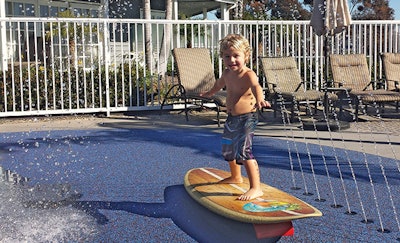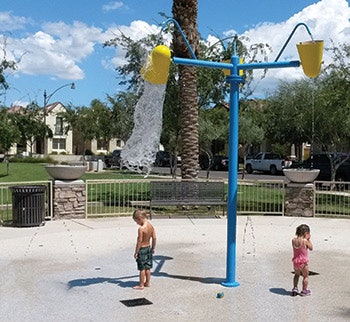
They’re bubbling up from Texas to Minnesota and from coast to coast as complements to existing pools, as well as stand-alone aquatics amenities replacing traditional pools altogether. And while most splash pads are part of a commercial project, you can find them in backyards as well, packed with howling neighborhood children in the summer months.
With little or no standing water (and thus no big safety issues), but a wide range of water-play options, splash pads represent a natural evolution of the backyard sprinkler cool-down concept. “The nice thing about splash pads is they’re very cross-generational,” says Ron Romens, owner and president of Commercial Recreation Specialists in Verona, Wis. “They represent a space where parents and grandparents can bring kids. The kids can play, and the moms have a cup of coffee. They don’t have to be right next to the kids in case they have to grab them like in a wading pool. It’s very much a social, community-building space.”
While the splash pad offers some obvious benefits and generates instant excitement, it tends to appeal to a narrower age range than traditional swimming pools. Toddlers through teens are its biggest enthusiasts.
Features: Water that jets upward out of the surface or can be manually aimed through nozzles appeals to toddlers, while teens seem to enjoy subjecting themselves to 50 gallons dumped at once. “When you design a splash pad, you really design it into zones and areas for those different ages of kids,” Romens says. “So in the toddler bay, you find laminar-type flow effects, features that are low to the toddler’s height, things that are easy to turn and interact with. When you get to the more active bay, now you’re putting in action-reaction play features where it takes multiple kids to get a different response from the water, by stepping on different jets or by moving things around. Then you get into competitive play.”
Specific features range from ground-level trenches with operable water-flow gates to animal sculptures that shoot water down from 15 feet overhead — the flow manipulated by kids pressing certain valve caps to reroute the water. The key is getting kids moving, even more than they might in a traditional pool setting, according to Ed Benck, owner of Aquatic Recreation Company LLC in Eden Prairie, Minn. “We have products that take two or three kids to really interact fully with the product, so they’re getting a little bit of a workout,” Benck says. “We make water tunnels that kids can run through to get them active, to get them moving around.”


Sequencing: Especially stimulating for young kids are a splash pad’s user-activated features. A child touches a bollard, which signals a controller to activate a percentage of play features for a preprogrammed period of time (say, four minutes). “So for every minute out of those four minutes, different features are coming on and off,” Romens says. “By these features being sequenced at different times and at different rates, it keeps it fresh for the kids.”
System type: Exactly what percentage of a splash pad’s features are active at any given time often depends on a most fundamental design consideration — the type of system specified. There are two approaches to splash pad mechanics: the flow-through system and recirculating system.
In a flow-through system, water from a potable source is pumped onto the pad and allowed to drain into the storm system. This method requires no water treatment and testing, but especially in a commercial splash pad the water consumed by such a system can make costs prohibitive.
A recirculating system, meanwhile, operates more like a pool — with chemicals, filters and pumps. Water is sent to the pad from a tank roughly four to five times the system’s flow rate.
In the interest of preserving water in a flow-through system, low-flow nozzles are typically specified, and perhaps only 60 percent of features are active at any given time, compared to 90 percent of features in a recirculating splash pad. Says Romens, “We could run it at 100 percent, but we like to do 80 because it’s always changing it up.” For these reasons, commercial splash pads that hope to cater to a wider range of age groups by enticing teens with “big water,” as Benck calls it, are likely better off with a recirculating system. “We prefer the bigger, heavier sprays with more water volume, because it’s just more fun for the kids,” he says.
There’s another advantage to recirculating water, Benck adds. “If it’s a drain-away system, their up-front costs are less, but they really compromise the play value of the splash pad, because now the kids are getting sprayed with cold municipal water, rather than a recirculating system in which the water is a more ambient temperature,” he says. “It’s like when you were a kid and you played with the hose at home: ‘This is fun, but, man, the water’s cold.’”
Benck’s firm has even installed recirculating splash pads with another common pool component: mechanical heat. “We have put in splash pads with heaters, so they can extend their season. They don’t use them much, but they probably use them for a couple of weeks in the spring and a couple of weeks in the fall,” Benck says. “When they close their municipal pools, they can keep the splash pad on.”
Surfacing: Brushed concrete is the most common splash pad surface, enhancing the safety and overall accessibility of the amenity. That said, manufacturers of resilient synthetic surfacing have emerged in recent years with products better suited to withstand the rigors of sun, chlorinated water and bacteria than previous formulations. “The broom finish is more cost-effective and it’s non-slip, but if the customer has it in the budget, resilient surfacing is a really good way to go because if you do slip on the broom finish, you’re going to get a raspberry,” says Benck, who also recommends synthetic safety surfacing in dry play areas that abut a splash pad, so mulch and sand aren’t tracked into the wet areas.
Splash pads have been around in various forms for decades, but their influence in the aquatics industry continues to spread. Their undeniable thrill has made them attractive to homeowners putting in high end backyard play areas, while in the commercial market, as more municipal pools become too old to justify their upkeep, aquatics alternatives that cost a fraction of what a new pool would cost to build and maintain look as enticing as a 50-gallon bucket dump on a 90-degree day.
Splashing In The Backyard
Just as the success of community pools spawned growth of residential pools, the commercial success of splash pads has led to an uptick in sales of home splash pads. As one would expect, the home versions are smaller and frequently simpler in design, but they are finding their own niche in the world of backyard aquatics based on the advantages they offer.
One of these is price point, according to John Foraker, vice president, My Splash Pad, Louisville, Ohio. The company sells and ships splash pad kits to builders, and also runs its own installation crews.
“A lot of people are trying to make their backyard into a vacation destination or they want to put a patio or kitchen out there — they want to spend time back there as a family — and they need a place for the kids to play. But they can’t afford a $40,000 swimming pool. A splash pad can bridge that gap at $15,000 to $25,000, entry-level,” Foraker says.
“It’s a less expensive way to get water-play for the kids, and you don’t have to worry about having to be back there watching them because it’s 100 percent safe, there’s no chance of drowning. That’s important to parents.”
Foraker says it’s difficult to profile his typical customer, but it’s mostly people that want to provide a play area that is easy to afford, operate and supervise.
“There are a lot of different situations where this fits. You have parents that want to add a little play area to an existing pool, you’ve got grandparents that just want a place for the grandkids when they come over. But we also have campgrounds and daycares that want the play area without the liability, so there’s no one type of customer.”
The company offers several completely different splash pad options. One option is simply to plumb into an existing pool’s circulation system, using its pump, filter, (heater, perhaps) and sanitization.
Another option is a standalone splash pad with its own circulation system.
A third, intriguing option is to hook up to the municipal water supply and drain to the sewer. This, in effect, creates a circulating system with a distant water treatment plant acting as the pump, filter and sanitizer.
“It’s a called a “Drain-Away” system,” says Foraker. “Some people tell me they think that’s a waste of water, but if you really think about it, you already have a $10 million city water treatment plant. Let them do what they do best — treat the water efficiently. By not having the pumps and equipment, you by-pass all that, it makes it a lot more economical to use and install.”
Foraker sees splash pads as a backyard product with a future because he says it makes a lot of sense for builders — obviously a key element in the product-to-market chain.
“It’s a great after-sale for the builder who already has a customer with a pool. That customer can add-on a play area for the kids using the existing pool plumbing. But it also works for the builder who meets a customer that can’t afford a pool. He can sell them a splash pad, and the customer gets a place for the kids to play, and the builder is still able to make a sale.”
Comments or thoughts on this article? Please e-mail [email protected].












































